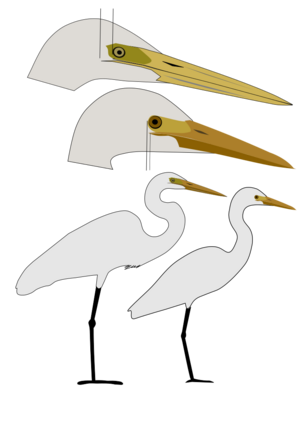Medium egret facts for kids
Quick facts for kids Medium egret |
|
|---|---|
 |
|
| Tokyo, Japan | |
| Conservation status | |
| Scientific classification | |
 |
|
| Breeding range Year-round range Wintering range Present during migration | |
| Synonyms | |
|
The medium egret (Ardea intermedia) is a beautiful, medium-sized heron. You might also hear it called the median egret, smaller egret, or intermediate egret. This bird lives all year round in parts of southern and eastern Asia.
Contents
About the Medium Egret
The medium egret is a white bird that stands between the very large great egret and smaller white egrets like the little egret. It usually measures about 56 to 72 centimeters (22 to 28 inches) long. Its wings can spread out to about 105 to 115 centimeters (41 to 45 inches) wide. This bird weighs around 400 grams (about 14 ounces).
It has all-white feathers, dark legs, and a thick yellow beak. When it's time to breed, the egret's beak might turn reddish or black. Its skin around the beak can become greenish-yellow. They also grow long, flowing feathers on their chest and back. The upper parts of their legs might turn dull yellow or pink. Both male and female egrets look very similar.
How to Tell Medium Egrets Apart
It can be tricky to tell different white egrets apart. Here are some clues:
- The medium egret is smaller than the great egret.
- Its neck is a bit shorter than its body.
- It has a slightly rounded head and a shorter, thicker beak.
- The great egret has a noticeable bend in the middle of its neck. Its long beak almost lines up with the flat top of its head.
- If you look closely, the great egret's mouth line goes behind its eye. The medium egret's mouth line ends below its eye.
- Medium egrets often walk upright with their neck stretched forward. Great egrets are more patient and might stand leaning to one side.
- Little egrets have black beaks and yellow feet. They often run around in shallow water to catch fish. Breeding little egrets have long feathers on the back of their heads.
What Medium Egrets Eat and How They Live
The medium egret is a skilled hunter. It quietly walks through shallow water, like coastal areas or flooded fields. It looks for fish, frogs, crabs, and insects to eat.
Reproduction and Life Cycle
Medium egrets often build their nests in groups called colonies. They usually nest with other herons. Their nests are made of sticks and are built in trees or bushes.
A female egret typically lays 2 or 3 eggs, but sometimes up to 6. The eggs are pale green and have a smooth shell. Both parents take turns sitting on the eggs to keep them warm. The eggs hatch after about 24 to 27 days. The chicks don't all hatch at the same time.
After hatching, the adult egrets protect their young for about 12 days. They defend the nest from birds that might try to attack. They crouch over the nest, raise their special feathers, and point their beak at any danger.
Parents feed their chicks by bringing up food from their own stomachs. At first, they drop the food onto the nest floor. Later, the chicks learn to take the food directly from the parent's mouth. Sometimes, the chicks might compete for food.
Young egrets start to grow their first feathers when they are about 4 days old. They can leave the nest when they are 24 days old, but they still come back to be fed. They learn to fly around 40 days old. They leave the colony completely after about 70 days. In places like Africa and Australia, many medium egret nests are successful. They raise at least one chick in most nests. These birds tend to have more success raising young in wet years compared to dry years.
Gallery
-
A medium egret descending to perch, Kabini River, India





